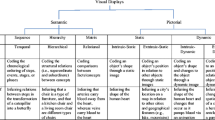Abstract
CPP-TRS (Tonfoni 1989–94) is both a methodology and a language. Through the methodology (CPP — Communicative Positioning Program) those invisible aspects of communication are identified and represented by the meta-language (TRS — Text Representation Systems), which complements natural language. CPP-TRS is a new paradigm which applies to any communicative context.
Icons in CPP-TRS are not intended to represent words or sentences in order to substitute them; they are rather intended to represent visually what natural language does not convey naturally. The improvement of communication is a challenge of the present and the future: CPP-TRS is designed explicitly for it.
The CPP-TRS system thus is able to support the user with a set of visual tools, that are specifically suited to structuring text and communicating effectively.
The same tools can support communication very effectively in situations where ambiguity can highly compromise the final result.
The system may be used in a way that is either opaque or transparent to the reader of the text.
Similar content being viewed by others
References
Beardon, C. (1993). Computer-Based Iconic Communication. In Ryan, K. & Sutcliffe, R. (eds.) AI and Cognitive Science '92, 263–76. Springer-Verlag, London, 1992.
Kay, A. (1990). User Interface: A Personal View, In Laurel, B. (ed.) The Art of Human-Computer Interface. Addison-Wesley: Reading, Mas.
Mc Kevitt, P. (1994). Visions for Language. Proceedings of The Workshop on Integration of Natural Language and Vision Processing. Twelfth American National Conference on Artificial Intelligence (AAAI-94), Seattle, Washington, USA.
Srihari, R. K. (1994–95). Computation Models for Interpreting Linguistic and Visual Information: A Survey. Artificial Intelligence Review 8: 349–369.
Tonfoni, G. (1991a). La Scrittura multimediale: Tecniche di progettazione e design testuale (Multimedia Writing: Textual Design and Architecturing), Treviso, Pagus.
Tonfoni, G. (1991b). La Communicazione aziendale come arte visiva (Business Communication as Visual Art), Treviso, Pagus.
Tonfoni, G. (1992). Partitura, solfeggio, movimento: Note di esecuzione di scrittura (Partition, Solfeggio, Movement: Notes on the Execution of Writing), Treviso, Pagus.
Tonfoni, G. (1994a). Abitare il testo (Living Text), Treviso, Pagus.
Tonfoni, G. (1994b). Writing as A Visual Art, Intellect, Oxford.
Tonfoni, G. (1994c). CPP-TRS: On Using Visual Cognitive Symbols to Enhance Communication Effectiveness, ISMCR-94, Topical Workshop on Virtual Reality, Proceedings of The Fourth International Symposium on Measurement and Control in Robotics, NASA, Houston, USA, Nov. 30–Dec. 3, 1994, Library of Congress#94-69310, 1994.
Tonfoni, G. (1996). Information States, Communicative Patterns, Textual Forms.
Yazdani, M. (1991). LINGERing On: Steps towards an ‘intelligent’ language tutoring environment. In Thompson, J. & Zähner, C. (eds.) Proceeding of The ICALL Workshop. CTI Centre for Modern Languages, University of Hull. Workshop held at UMIST.
Author information
Authors and Affiliations
Additional information
Author of CPP-TRS¢ and CPP-TRS¢ Applications Designer.
Rights and permissions
About this article
Cite this article
Tonfoni, G. A visual news processing environment. Artif Intell Rev 10, 187–208 (1996). https://doi.org/10.1007/BF00127679
Issue Date:
DOI: https://doi.org/10.1007/BF00127679




